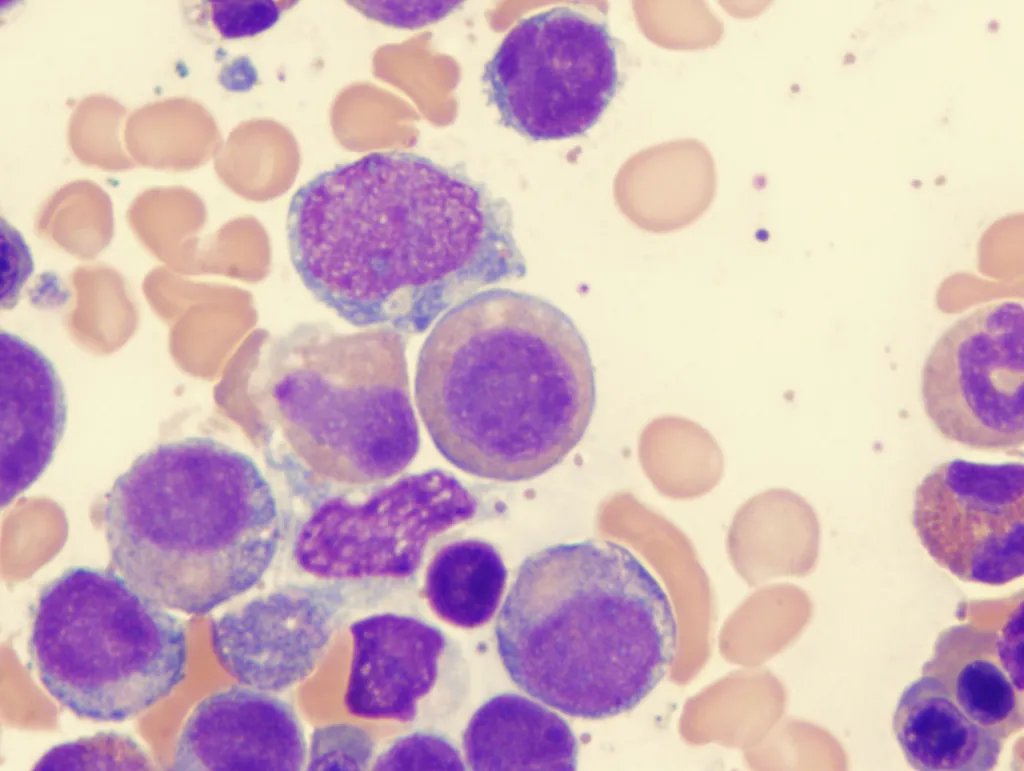Aplastic Anemia and Myelodysplastic Syndromes: Similarities and Differences

Aplastic anemia and myelodysplastic syndromes (MDS) both refer to disorders that affect the bone marrow and blood. Both disorders are characterized by damaged bone marrow that cannot produce an adequate amount of healthy blood cells, but they are two different conditions.
In aplastic anemia, many bone marrow stem cells are damaged or destroyed, resulting in fewer healthy blood cells. However, the cells that are produced are healthy. Severe aplastic anemia is often considered an autoimmune disorder.
MDS is a group of diseases that affect the blood-forming cells in the bone marrow. The damaged bone marrow stem cells produce abnormal blood cells that do not function properly, meaning there are fewer healthy blood cells. MDS is considered to be a cancerous disease.
How Common are Aplastic Anemia and MDS?
Aplastic anemia affects around 2 people per million in the U.S. each year. It generally affects men and women equally and can affect people of any age, but it is more common in younger people.
MDS, while still rare, is more common than aplastic anemia, with around 4 new cases per 100,000 people in the U.S. every year. While MDS can affect any age group, it is more common in people aged 60 years and over. Men are twice as likely to be diagnosed with MDS than women.
What are the Similarities Between Aplastic Anemia and MDS?
Similar symptoms
The signs and symptoms of aplastic anemia and MDS can be very similar, although the severity can vary greatly between individuals and even within the same condition. Common symptoms include:
- Fatigue: Feeling unusually tired or weak.
- Infections: Experiencing infections more frequently than usual.
- Bleeding problems: This can include frequent nosebleeds, bleeding gums, easy bruising, or bleeding that takes a long time to stop.
- Pale skin: Looking unusually pale.
- Shortness of breath: Difficulty breathing, especially during physical activity.
- Petechiae: Small red or purple spots on the skin caused by tiny bleeds.
- Rapid or irregular heartbeat: A noticeable change in heart rhythm.
- Dizziness: Feeling lightheaded or unsteady.
- Fever: A high temperature.
- Headache: Persistent headaches.
If you experience a fever or bleeding that will not stop, contact your healthcare team as soon as possible.
Similar Diagnostic Tests
The tests used by healthcare professionals to diagnose aplastic anemia and MDS are similar. These typically include:
-
Complete Blood Count (CBC): This common blood test measures different components of your blood, including red blood cells, white blood cells, platelets, and hemoglobin. It helps identify abnormalities in blood cell counts.
-
Blood smear: A small drop of blood is examined under a microscope to check the size, shape, and number of blood cells.
-
Bone marrow aspiration and biopsy: These procedures examine the bone marrow directly to assess the quantity, variety, size, and shape of blood cells, as well as look for abnormal cells and genetic changes. This is often the most definitive way to diagnose aplastic anemia or MDS.
-
Genetic tests: These tests can identify specific genetic mutations or chromosomal abnormalities that may be causing or contributing to the condition. One example is flow cytometry, which measures the number, viability, size, and shape of cells.
Similar Treatment Strategies
While the specific treatment plan will depend on the individual and the specific diagnosis, some common treatments are used for both aplastic anemia and MDS, such as blood transfusions, bone marrow stem cell transplantation, and treatments to prevent infections. Treatment for both conditions often focuses on alleviating symptoms and improving quality of life. Patients with mild forms of either condition may not need treatment immediately but will be closely monitored.
What are the Differences Between Aplastic Anemia and MDS?
There are important differences between the two conditions, and understanding them can be crucial for proper diagnosis and treatment.
Different causes and Risk factors
Although both conditions affect blood cell production, their underlying causes and risk factors can vary.
Aplastic Anemia:
-
Often unknown (Idiopathic): In many cases, the exact cause of aplastic anemia remains unknown.
-
Acquired or inherited: Aplastic anemia can develop during a person's lifetime (acquired) or be inherited through genes passed down from parents.
-
Risk factors:
-
Autoimmune diseases
-
Viral infections (e.g., hepatitis)
-
Pregnancy
-
Certain medications (e.g., sulfonamides, antiseizure drugs)
-
Exposure to toxins (e.g., pesticides, benzene)
-
Genetic bone marrow failure syndromes (e.g., Fanconi anemia, Shwachman-Diamond syndrome)
MDS (Myelodysplastic Syndromes):
-
The exact causes are unknown but it’s often linked to genetic alterations: Many MDS cases are associated with changes in specific genes.
-
Risk Factors:
-
Older age
-
Exposure to toxins (e.g., pesticides, benzene)
-
Smoking
-
Prior chemotherapy or radiation therapy
-
Certain genetic bone marrow failure conditions (e.g., Fanconi anemia, Diamond-Blackfan anemia, dyskeratosis congenita)
Different treatment options
There are treatment options specific for patients with MDS, particularly for patients who have a high risk of progressing to acute myeloid leukemia (AML). These include:
-
Hypomethylating agents, such as azacitidine and decitabine, prevent the growth of abnormal cells
-
Immune modulators, such as lenalidomide, slow the growth of abnormal cells and reduce the requirement for blood transfusions.
-
Chemotherapeutic agents for younger and fitter patients, such as cytarabine, daunorubicin, and idarubicin. Generally, a more intensive treatment that kills the cancer cells.
Key takeaways
-
Aplastic anemia and MDS are both disorders that affect the bone marrow and blood, resulting in an inadequate amount of healthy blood cells
-
Aplastic anemia is considered an autoimmune disorder, while MDS is considered cancerous
-
The symptoms, diagnostic tests, and some of the treatment options are similar between aplastic anemia and MDS
-
Several risk factors are unique to each condition, and some treatments, such as hypomethylating agents, immune modulators, and chemotherapy, are only used in patients with high-risk MDS
Become a cure contributor by creating a HealthTree account!
By creating an account, you can have all the labs from different facilities in one place, and you can easily track and monitor them for free.
Sources:
-
Aplastic Anemia & Myelodysplastic Syndromes. https://www.niddk.nih.gov/health-information/blood-diseases/aplastic-anemia-myelodysplastic-syndromes
-
What Is the Difference Between Aplastic Anemia and Myelodysplastic Syndrome. https://www.moffitt.org/cancers/myelodysplastic-syndromes-mds/faqs/what-is-the-difference-between-aplastic-anemia-and-myelodysplastic-syndrome/
-
Myelodysplastic syndromes (MDS) Recent Trends in SEER Age-Adjusted Incidence Rates, 2001-2021. https://seer.cancer.gov/statistics-network/explorer/application.html?site=409&data_type=1&graph_type=2&compareBy=sex&chk_sex_1=1&rate_type=2&race=1&age_range=1&hdn_stage=101&advopt_precision=1&advopt_show_ci=on&hdn_view=0&advopt_show_apc=on&advopt_display=2
Aplastic anemia and myelodysplastic syndromes (MDS) both refer to disorders that affect the bone marrow and blood. Both disorders are characterized by damaged bone marrow that cannot produce an adequate amount of healthy blood cells, but they are two different conditions.
In aplastic anemia, many bone marrow stem cells are damaged or destroyed, resulting in fewer healthy blood cells. However, the cells that are produced are healthy. Severe aplastic anemia is often considered an autoimmune disorder.
MDS is a group of diseases that affect the blood-forming cells in the bone marrow. The damaged bone marrow stem cells produce abnormal blood cells that do not function properly, meaning there are fewer healthy blood cells. MDS is considered to be a cancerous disease.
How Common are Aplastic Anemia and MDS?
Aplastic anemia affects around 2 people per million in the U.S. each year. It generally affects men and women equally and can affect people of any age, but it is more common in younger people.
MDS, while still rare, is more common than aplastic anemia, with around 4 new cases per 100,000 people in the U.S. every year. While MDS can affect any age group, it is more common in people aged 60 years and over. Men are twice as likely to be diagnosed with MDS than women.
What are the Similarities Between Aplastic Anemia and MDS?
Similar symptoms
The signs and symptoms of aplastic anemia and MDS can be very similar, although the severity can vary greatly between individuals and even within the same condition. Common symptoms include:
- Fatigue: Feeling unusually tired or weak.
- Infections: Experiencing infections more frequently than usual.
- Bleeding problems: This can include frequent nosebleeds, bleeding gums, easy bruising, or bleeding that takes a long time to stop.
- Pale skin: Looking unusually pale.
- Shortness of breath: Difficulty breathing, especially during physical activity.
- Petechiae: Small red or purple spots on the skin caused by tiny bleeds.
- Rapid or irregular heartbeat: A noticeable change in heart rhythm.
- Dizziness: Feeling lightheaded or unsteady.
- Fever: A high temperature.
- Headache: Persistent headaches.
If you experience a fever or bleeding that will not stop, contact your healthcare team as soon as possible.
Similar Diagnostic Tests
The tests used by healthcare professionals to diagnose aplastic anemia and MDS are similar. These typically include:
-
Complete Blood Count (CBC): This common blood test measures different components of your blood, including red blood cells, white blood cells, platelets, and hemoglobin. It helps identify abnormalities in blood cell counts.
-
Blood smear: A small drop of blood is examined under a microscope to check the size, shape, and number of blood cells.
-
Bone marrow aspiration and biopsy: These procedures examine the bone marrow directly to assess the quantity, variety, size, and shape of blood cells, as well as look for abnormal cells and genetic changes. This is often the most definitive way to diagnose aplastic anemia or MDS.
-
Genetic tests: These tests can identify specific genetic mutations or chromosomal abnormalities that may be causing or contributing to the condition. One example is flow cytometry, which measures the number, viability, size, and shape of cells.
Similar Treatment Strategies
While the specific treatment plan will depend on the individual and the specific diagnosis, some common treatments are used for both aplastic anemia and MDS, such as blood transfusions, bone marrow stem cell transplantation, and treatments to prevent infections. Treatment for both conditions often focuses on alleviating symptoms and improving quality of life. Patients with mild forms of either condition may not need treatment immediately but will be closely monitored.
What are the Differences Between Aplastic Anemia and MDS?
There are important differences between the two conditions, and understanding them can be crucial for proper diagnosis and treatment.
Different causes and Risk factors
Although both conditions affect blood cell production, their underlying causes and risk factors can vary.
Aplastic Anemia:
-
Often unknown (Idiopathic): In many cases, the exact cause of aplastic anemia remains unknown.
-
Acquired or inherited: Aplastic anemia can develop during a person's lifetime (acquired) or be inherited through genes passed down from parents.
-
Risk factors:
-
Autoimmune diseases
-
Viral infections (e.g., hepatitis)
-
Pregnancy
-
Certain medications (e.g., sulfonamides, antiseizure drugs)
-
Exposure to toxins (e.g., pesticides, benzene)
-
Genetic bone marrow failure syndromes (e.g., Fanconi anemia, Shwachman-Diamond syndrome)
MDS (Myelodysplastic Syndromes):
-
The exact causes are unknown but it’s often linked to genetic alterations: Many MDS cases are associated with changes in specific genes.
-
Risk Factors:
-
Older age
-
Exposure to toxins (e.g., pesticides, benzene)
-
Smoking
-
Prior chemotherapy or radiation therapy
-
Certain genetic bone marrow failure conditions (e.g., Fanconi anemia, Diamond-Blackfan anemia, dyskeratosis congenita)
Different treatment options
There are treatment options specific for patients with MDS, particularly for patients who have a high risk of progressing to acute myeloid leukemia (AML). These include:
-
Hypomethylating agents, such as azacitidine and decitabine, prevent the growth of abnormal cells
-
Immune modulators, such as lenalidomide, slow the growth of abnormal cells and reduce the requirement for blood transfusions.
-
Chemotherapeutic agents for younger and fitter patients, such as cytarabine, daunorubicin, and idarubicin. Generally, a more intensive treatment that kills the cancer cells.
Key takeaways
-
Aplastic anemia and MDS are both disorders that affect the bone marrow and blood, resulting in an inadequate amount of healthy blood cells
-
Aplastic anemia is considered an autoimmune disorder, while MDS is considered cancerous
-
The symptoms, diagnostic tests, and some of the treatment options are similar between aplastic anemia and MDS
-
Several risk factors are unique to each condition, and some treatments, such as hypomethylating agents, immune modulators, and chemotherapy, are only used in patients with high-risk MDS
Become a cure contributor by creating a HealthTree account!
By creating an account, you can have all the labs from different facilities in one place, and you can easily track and monitor them for free.
Sources:
-
Aplastic Anemia & Myelodysplastic Syndromes. https://www.niddk.nih.gov/health-information/blood-diseases/aplastic-anemia-myelodysplastic-syndromes
-
What Is the Difference Between Aplastic Anemia and Myelodysplastic Syndrome. https://www.moffitt.org/cancers/myelodysplastic-syndromes-mds/faqs/what-is-the-difference-between-aplastic-anemia-and-myelodysplastic-syndrome/
-
Myelodysplastic syndromes (MDS) Recent Trends in SEER Age-Adjusted Incidence Rates, 2001-2021. https://seer.cancer.gov/statistics-network/explorer/application.html?site=409&data_type=1&graph_type=2&compareBy=sex&chk_sex_1=1&rate_type=2&race=1&age_range=1&hdn_stage=101&advopt_precision=1&advopt_show_ci=on&hdn_view=0&advopt_show_apc=on&advopt_display=2

about the author
Dylan Barrett
Dylan is a freelance medical writer based in Cork, Ireland. He previously worked in independent medical education while living in London and is now collaborating with HealthTree to develop resources for blood cancer patients. His background is in genetics, and he has a passion for innovative scientific research. In his spare time, he enjoys sports, traveling, and spending time with his family and friends.
More on Navigating Your Health
Trending Articles
Get the Latest Myelodysplastic Syndromes Updates, Delivered to You.
By subscribing to the HealthTree newsletter, you'll receive the latest research, treatment updates, and expert insights to help you navigate your health.
Together we care.
Together we cure.
3x Faster.








